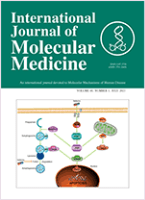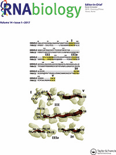
INTERNATIONAL JOURNAL OF MOLECULAR MEDICINE
Scope & Guideline
Innovating insights in molecular biology and genetics.
Introduction
Aims and Scopes
- Molecular Mechanisms of Disease:
The journal frequently publishes studies elucidating the molecular underpinnings of various diseases, including cancer, diabetes, cardiovascular disorders, and neurodegenerative diseases. This includes research on gene expression, signaling pathways, and cellular responses. - Therapeutic Strategies and Drug Development:
A significant focus is placed on novel therapeutic strategies and drug development, particularly in cancer therapy and regenerative medicine. This encompasses studies on small molecules, biologics, and advanced therapies such as gene editing and stem cell applications. - Role of Non-Coding RNAs and Epigenetics:
The journal showcases research on the regulatory roles of non-coding RNAs, including microRNAs and long non-coding RNAs, in gene expression and their implications in disease processes and therapy. - Immunology and Inflammation:
Studies related to the immune system, inflammatory responses, and their implications in diseases such as autoimmune disorders and cancer are prominent, highlighting the intersection of molecular medicine and immunology. - Translational Research:
The journal emphasizes translational research that connects laboratory findings with clinical applications, aiming to enhance understanding and treatment of diseases through innovative approaches. - Emerging Technologies:
The integration of novel technologies, including CRISPR, nanomedicine, and advanced imaging techniques, is a recurring theme, reflecting the journal's commitment to cutting-edge scientific advancements.
Trending and Emerging
- Role of Microbiome in Health and Disease:
Research on the human microbiome and its influence on health and disease is gaining momentum, particularly in relation to metabolic disorders, autoimmune diseases, and cancer. - Ferroptosis and Regulated Cell Death:
The exploration of ferroptosis and other forms of regulated cell death is becoming increasingly prominent, particularly in the context of cancer and neurodegenerative diseases, as researchers seek to understand and manipulate these pathways for therapeutic benefit. - Advanced Biomaterials and Regenerative Medicine:
There is a growing interest in the development of innovative biomaterials and their applications in regenerative medicine, including tissue engineering and wound healing. - Gene Editing and CRISPR Technologies:
The application of CRISPR and other gene-editing technologies is emerging as a significant area of research, with studies exploring their potential in treating genetic disorders and cancer. - Immunotherapy Innovations:
Immunological approaches, particularly novel immunotherapies for cancer and autoimmune disorders, are trending, with increased focus on understanding immune checkpoints and developing combination therapies. - Personalized Medicine and Genomic Approaches:
The journal is increasingly publishing research that focuses on personalized medicine, utilizing genomic data to tailor treatments to individual patients based on their unique genetic and molecular profiles.
Declining or Waning
- Traditional Pharmacology and Single-Agent Studies:
There has been a noticeable decline in studies focused solely on traditional pharmacological approaches and single-agent therapies, as the field increasingly moves towards combination therapies and personalized medicine. - Basic Mechanistic Studies Without Clinical Relevance:
Papers that focus exclusively on basic mechanistic insights without clear clinical implications or translational potential are appearing less frequently as the journal prioritizes research that bridges basic science with clinical applications. - Animal Models of Disease:
Research relying heavily on conventional animal models without addressing translational relevance is declining, as there is a growing emphasis on humanized models or more sophisticated in vitro systems that better mimic human pathophysiology. - Static Disease Models:
Studies employing static models of disease that do not incorporate dynamic or multi-faceted approaches are less common, as researchers favor more comprehensive systems that reflect the complexities of human diseases.
Similar Journals

RNA
Exploring the Essence of Life Through RNARNA is a premier journal in the field of molecular biology, published by COLD SPRING HARBOR LAB PRESS, PUBLICATIONS DEPT. With an impressive impact factor reflected by its Q1 status in the Molecular Biology category, this journal has established itself as an essential resource for researchers and professionals dedicated to understanding the role of RNA in biological processes. Spanning over two decades of impactful research from 1995 to 2024, RNA covers a broad spectrum of topics, including RNA biology, gene regulation, and therapeutic innovations. Researchers can access its extensive array of original research articles, reviews, and commentary, making it a vital conduit for new discoveries and methodologies in the field. With its high ranking within Scopus at Rank #115/410 and a 72nd percentile ranking in the domain of Biochemistry, Genetics, and Molecular Biology, RNA continues to advance the understanding of RNA and its critical contributions to life sciences.

INTERNATIONAL JOURNAL OF BIOCHEMISTRY & CELL BIOLOGY
Shaping the Future of Biochemistry and Cell BiologyThe International Journal of Biochemistry & Cell Biology, published by Pergamon-Elsevier Science Ltd, stands as a pivotal resource in the fields of biochemistry and cell biology. With an ISSN of 1357-2725 and an E-ISSN of 1878-5875, this prestigious journal has been a key platform for disseminating cutting-edge research since its inception in 1995. The journal currently holds an impressive Q1 ranking in Biochemistry and a Q2 ranking in Cell Biology for the year 2023, reflecting its commitment to high-quality research and its influence within the scientific community. With a significant Scopus ranking of 94/438 in Biochemistry and 96/285 in Cell Biology, the journal plays a crucial role in advancing knowledge and fostering innovative approaches in these dynamic fields. Though it is not an open-access journal, the International Journal of Biochemistry & Cell Biology remains accessible to a wide audience, making it a vital resource for researchers, professionals, and students alike, who are eager to explore and contribute to the ongoing advancements in biochemistry and cell biology.

JOURNAL OF GENE MEDICINE
Elevating Standards in Gene Medicine ResearchThe Journal of Gene Medicine, published by Wiley, stands as a pivotal resource in the field of gene therapy and molecular medicine, with a rich history of dissemination of impactful research since its inception in 1998. With an ISSN of 1099-498X and an E-ISSN of 1521-2254, this esteemed journal plays a crucial role in advancing our understanding of genetics and drug discovery, reflected in its impressive 2023 Scopus rankings where it holds a Q2 classification in Drug Discovery and Q3 in several genetics-related categories. The journal aims to facilitate the exchange of high-quality research findings that bridge the gap between laboratory and clinical applications, making it an essential platform for researchers, academics, and healthcare professionals committed to the forefront of genetic innovation. Although it does not currently offer open access options, its reputation for rigorous peer review ensures that all published work meets the highest academic standards, providing a reliable reference for scientific inquiry in the United States and beyond. As the field rapidly evolves, the Journal of Gene Medicine remains at the helm, guiding future discoveries with its influential publications and comprehensive insights.

Cancer Cell International
Connecting Researchers to Combat CancerCancer Cell International, published by BMC, is a transformative open-access journal established in 2001, dedicated to advancing the field of oncology and cancer research. With its ISSN number not specified and an E-ISSN of 1475-2867, the journal proudly operates from the United Kingdom, located at CAMPUS, 4 Crinan St, London N1 9XW, England. Renowned for its rigorous peer-review process, Cancer Cell International has made significant strides, securing a Q2 ranking in Cancer Research and Q1 rankings in both Genetics and Oncology as of 2023. It ranks impressively in Scopus, featuring in the top quintile of Genetics (#37/347) and Oncology (#52/404), indicating its importance within the scientific community. The journal's broad scope caters to a diverse array of topics within cancer biology, making it an invaluable resource for researchers, professionals, and students seeking to stay at the forefront of cancer science. With a commitment to disseminating high-quality research, Cancer Cell International invites scholars to explore innovative findings and contribute to the collective effort of combating cancer.

CYTOTECHNOLOGY
Innovative Insights: Shaping the Future of Bioengineering and Biotechnology.CYTOTECHNOLOGY, an esteemed journal published by Springer, stands as a vital resource in the fields of Bioengineering, Biomedical Engineering, and Biotechnology. With an impact factor reflective of its solid position within academia, this journal encompasses a broad scope dedicated to the advancement of cytotechnological research and applications from its inception in 1987 through to its latest volumes in 2024. Based in the Netherlands, it is committed to providing researchers, professionals, and students with high-quality, peer-reviewed articles that contribute to the understanding and innovations in cytotechnology. Although currently not open access, CYTOTECHNOLOGY has garnered a commendable reputation, holding Q3 rankings in multiple categories, indicating its relevance and influence within the scientific community. Researchers are encouraged to submit their cutting-edge findings to share insights that can spark further advancements in this dynamic field.

MedComm is a distinguished Open Access journal published by Wiley, located in the United States. Since its inception in 2020, it has rapidly established itself as a leading platform for cutting-edge research in the fields of Biochemistry, Cell Biology, Drug Discovery, Genetics, Immunology and Allergy, and Oncology, achieving a prestigious Q1 category ranking across multiple disciplines in 2023. MedComm is committed to providing a rigorous and transparent peer-review process, ensuring the publication of high-quality articles that advance the frontiers of medical science. With its remarkable Scopus ranking, the journal serves as an invaluable resource for researchers, professionals, and students looking to stay abreast of important developments in the life sciences. The open access model facilitates widespread dissemination of scholarly work, fostering collaboration and innovation within the global scientific community. Researchers interested in submitting their work or exploring the latest findings are encouraged to engage with this pivotal journal during the converged years from 2020 to 2024.

CELLULAR AND MOLECULAR LIFE SCIENCES
Exploring the Dynamic Interplay of Cells and MoleculesCELLULAR AND MOLECULAR LIFE SCIENCES, published by SPRINGER BASEL AG, stands as a premier journal dedicated to advancing the field of cellular and molecular biology. With an impressive 2023 impact factor reflected in its Q1 rankings across key categories—including Cell Biology, Molecular Biology, and Pharmacology—it serves as a critical platform for researchers aiming to disseminate high-quality findings in these dynamic fields. Operated under an open access framework, the journal allows broader accessibility to groundbreaking research, fostering collaboration amongst scientists globally. Based in Switzerland, CELLULAR AND MOLECULAR LIFE SCIENCES has been at the forefront of scientific publishing since 1952, adapting to contemporary scientific challenges and trends, ultimately shaping the future of life sciences.

RNA Biology
Elevating RNA Studies to New HeightsRNA Biology is a premier journal published by Taylor & Francis Inc, focusing on the intricate and evolving field of RNA research. With an ISSN of 1547-6286 and E-ISSN of 1555-8584, this journal has established itself as an essential resource for professionals, researchers, and students engaged in both molecular and cell biology. Recognized in the 2023 quartile rankings, RNA Biology holds a distinguished Q1 category in Molecular Biology and a Q2 category in Cell Biology, indicative of its significant impact and reputation within the scientific community. The journal emphasizes the importance of RNA in various biological processes, highlighting both fundamental and applied aspects, which is crucial for advancing our understanding of gene expression and regulation. With a strong Scopus ranking, including Rank #105/410 in Molecular Biology and Rank #83/285 in Cell Biology, RNA Biology is not just a publication but a vital platform for sharing groundbreaking findings and insights into RNA research. With a convergence that spans from 2004 to 2024, the journal promises to continue its legacy of excellence in disseminating important discoveries in RNA science, contributing richly to ongoing scientific dialogue and innovation.

MOLECULAR MEDICINE
Bridging Research and Practice in Molecular MedicineMOLECULAR MEDICINE, published by SPRINGER, is a leading scholarly journal dedicated to advancing the fields of genetics and molecular biology with a focus on clinical applications. Since its inception in 1994, it has evolved to become a pivotal platform for disseminating innovative research findings, achieving a remarkable Q1 ranking in multiple categories, including Genetics, Molecular Biology, and Molecular Medicine as of 2023. Featuring an Open Access model since 2000, the journal ensures that cutting-edge research is freely available to the global scientific community, facilitating collaboration and knowledge exchange. With a commitment to high-quality peer-reviewed content, MOLECULAR MEDICINE serves as an essential resource for researchers, healthcare professionals, and students seeking to stay at the forefront of molecular research and its implications for medical science. For those interested in contributing to or accessing vital research in this dynamic field, MOLECULAR MEDICINE stands out as a premier choice.

International Journal of Biological Sciences
Connecting Researchers to the Pulse of Life SciencesInternational Journal of Biological Sciences (ISSN: 1449-2288, E-ISSN: 1449-2288) is a premier open-access journal published by IVYSPRING INTERNATIONAL PUBLISHING since 2005, located in Australia. With a commitment to advancing knowledge in the life sciences, this journal covers a wide spectrum of disciplines, including Applied Microbiology and Biotechnology, Cell Biology, Developmental Biology, Ecology, Evolution, Behavior and Systematics, and Molecular Biology, earning a distinguished Q1 ranking in these fields as of 2023. It stands out with exceptional Scopus rankings, placing in the top ranks across multiple categories, such as the 98th percentile in Ecology, Evolution, Behavior and Systematics and the 94th percentile in Applied Microbiology and Biotechnology. The journal fosters an open access philosophy, ensuring that research findings are readily available to the scientific community and the public, and invites original research articles, reviews, and commentaries. With its mission to disseminate high-quality research, the International Journal of Biological Sciences serves as an essential resource for researchers, professionals, and students seeking to deepen their understanding and drive innovation in biological sciences.